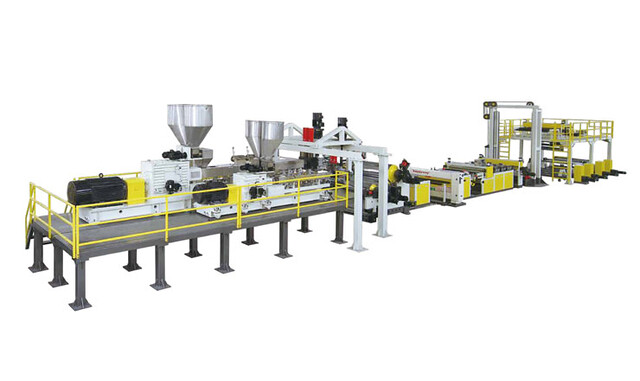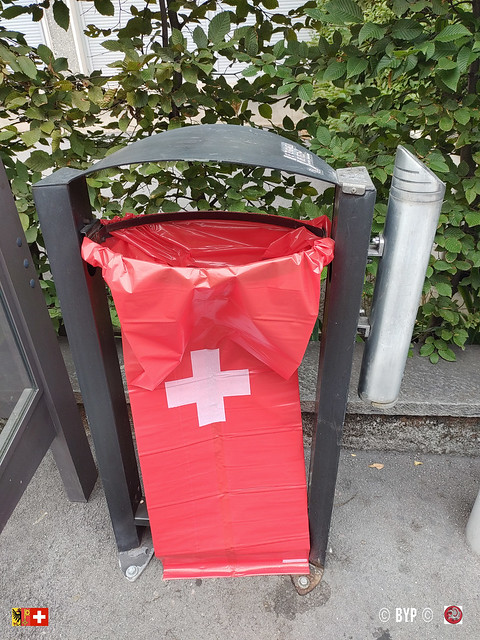Blow Molding Machines
Blow molding machines are used to produce hollow plastic products such as bottles and containers. This versatile manufacturing process is utilized in a wide variety of industries to create products that are essential to our daily lives.
Plastic resin pellets are fed into a hopper and melted through an Archimedean screw or accumulator. Once the molten plastic is sufficiently heated, it’s blown into a mold and expanded with compressed air to form the final product shape.
Extrusion Blow Molding
In extrusion blow molding (EBM) pelletized raw plastic is fed into an extruder barrel and screw assembly where it is heated and plasticized. Once the molten plastic reaches a predetermined length it is led through a die which typically creates a tubular cross-section (parison) of an approximate final part shape and wall thickness. This hanging vertical parison is then closed in a hollow mold and air blown into it to inflate it to the desired shape of the product.
Upon cooling the inflated parison holds the product shape as it is removed from the mold. This process can be divided into two subcategories; continuous extrusion and intermittent extrusion. With continuous extrusion the machine runs continuously with the extruder head continually feeding material into a reservoir until a ram pushes it through a die to form the inflated parison. With intermittent extrusion the machine runs for a set period of time with the extruder head filling an accumulator before a ram is activated to extrude the parison through a die and into the product mold for inflation.
This process is used to produce a wide range of bottles and jars and other hollow plastic products with a high volume-to-weight ratio. It is also a popular choice for manufacture of plastic tubing and other pipe products as it is capable of producing a wide range of diameters.
Injection Blow Molding
Injection blow molding is used to make plastic containers that are hollow – think bottles of liquid laundry detergent and shampoo. First, the melted plastic is injected into a split steel mold that looks like a test tube, forming a preform parison. Then, the parison is moved to a second mold and air is blown into it, making it inflate and take on the shape of the container. Finally, it is cooled and ejected from the mold.
This process is more expensive than extrusion, but it produces high-quality containers with blow molding machine uniform wall thickness and tighter tolerances. It can also produce larger containers, such as automobile gas tanks. The key to successful injection blow molding is choosing the right thermoplastic resin, as it can impact wall thickness uniformity and stiffness. Arlington Machinery recommends using a low molecular weight polymer with good mechanical properties.
Injection blow molding is a versatile process, and we offer several different types of machines to suit your needs. For example, our MSZ70 machine is designed for injection blow molding and offers a variety of features to optimize production. Other options include our rotary wheel and stretch blow molding machines. Contact us to discuss your application and see what we can do for you. We offer comprehensive machine servicing and maintenance to keep your equipment running smoothly.
Rotating Wheel Blow Molding
Often used for high volume production of plastic containers, rotary blow molding machines feature multiple molds on a rotating wheel. Each of these “stations” can be set up to perform different blow molding processes, including parison clamping, inflating, cooling, and ejecting. The rotary wheel is also designed to allow for In Mold Labeling (IML).
Blow molding is a highly versatile process that’s capable of producing hollow products from a wide range of raw materials, including polyethylene, polyethylene terephthalate, and polypropylene. Bottles and packaging represent the primary application for this technology.
A rotating wheel blow molding machine is shown in FIG. 1. The mold wheel 100 is positioned with 12 molds 120 attached to its outer perimeter. At some point during a cycle the molds are closed to capture parison and then inflated with blow air for a duration 200. The inflated parison is then cut away from the remaining parts of the container and allowed to cool. Molds 120 are subsequently opened to release the molded container.
Compared to shuttle or reciprocating screw machinery, rotary wheel machinery can achieve very tight weight and tolerance consistency because each container is blown with a single parison. However, this type of equipment is typically committed to a narrow range of sizes after it’s built and product changeover can be difficult.
Continuous Blow Molding
Blow molding is a popular and effective method to manufacture hollow-bodied plastic workpieces. The process starts by heating a preform, which is then pressed into a mold and inflated with compressed air. The finished workpiece can be a variety of shapes and sizes. It is commonly used to make bottles and containers. It can also blow molding machine factory be used to create a wide range of other products, such as toys, toys, and automotive components.
There are two main types of blow mold machines: Continuous and intermittent. Extrusion blow molding can be continuous or intermittent, and the distinction lies in how the polymer is molded into the parison. Continuous extrusion has a process similar to injection molding. Each new piece of plastic is extruded and then cut off with a knife. Intermittent extrusion is a bit more complicated, but it works by using an accumulator to gather melted plastic and then forcing it into the metal mold when it is ready.
Both of these methods are known for producing high-quality, consistent results and are ideal for mid to large run production. Unlike injection blow molding, which is best for larger volumes, this process requires less investment in equipment and can be used to produce smaller products as well. However, this type of machine is not suitable for use with high-density plastic materials like PET or PP.


